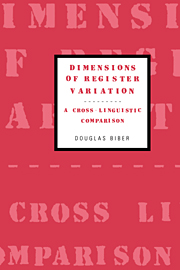Book contents
- Frontmatter
- Contents
- List of figures
- List of tables
- Acknowledgments
- List of abbreviations
- 1 Introduction
- 2 The comprehensive analysis of register variation
- 3 Sociocultural description of the four language situations
- 4 The linguistic bases of cross-linguistic register comparisons: a detailed quantitative comparison of English and Somali registers
- 5 Methodology
- 6 Multi-Dimensional analyses of the four languages
- 7 Cross-linguistic patterns of register variation: synchronic similarities and differences
- 8 Cross-linguistic patterns of register variation: diachronic similarities and differences
- 9 Registers and text types in English and Somali
- 10 Towards cross-linguistic universals of register variation
- Appendix I Grammatical description of linguistic features in Korean. Yong-Jin Kim
- Appendix II Grammatical description of linguistic features in Somali. With Mohamed Hared
- Notes
- References
- Index
10 - Towards cross-linguistic universals of register variation
Published online by Cambridge University Press: 07 September 2009
- Frontmatter
- Contents
- List of figures
- List of tables
- Acknowledgments
- List of abbreviations
- 1 Introduction
- 2 The comprehensive analysis of register variation
- 3 Sociocultural description of the four language situations
- 4 The linguistic bases of cross-linguistic register comparisons: a detailed quantitative comparison of English and Somali registers
- 5 Methodology
- 6 Multi-Dimensional analyses of the four languages
- 7 Cross-linguistic patterns of register variation: synchronic similarities and differences
- 8 Cross-linguistic patterns of register variation: diachronic similarities and differences
- 9 Registers and text types in English and Somali
- 10 Towards cross-linguistic universals of register variation
- Appendix I Grammatical description of linguistic features in Korean. Yong-Jin Kim
- Appendix II Grammatical description of linguistic features in Somali. With Mohamed Hared
- Notes
- References
- Index
Summary
The preceding chapters have shown that the patterns of linguistic variation among texts are strikingly similar across languages. These cross-linguistic similarities hold at several levels:
for the co-occurrence patterns among linguistic features, and the ways in which features function together as underlying dimensions;
for the synchronic relations among registers within a language, including the multidimensional characteristics of particular registers, and the patterns of variation among registers;
for the diachronic patterns of change within and among registers, in response to changing communicative needs and circumstances following the introduction of written registers in a society;
for the text types that are well defined linguistically.
Given the strength of these patterns, it is reasonable to hold out the possibility of cross-linguistic universals governing the patterns of discourse variation across registers and text types. However, considerable additional research is required to determine which of the cross-linguistic generalizations identified in the present study are valid as universals, and to formulate more precise statements of those relationships.
One of the most important issues requiring further investigation is the role of literacy in defining the synchronic and diachronic patterns of register variation. From a synchronic perspective, differences in the repertoire of written registers correspond to different multidimensional profiles across languages: for example, the register and text type analyses of English, Korean, and Somali show that written registers – informational and expository registers as well as fiction and letters – vary systematically along several underlying dimensions.
Information
- Type
- Chapter
- Information
- Dimensions of Register VariationA Cross-Linguistic Comparison, pp. 359 - 363Publisher: Cambridge University PressPrint publication year: 1995
